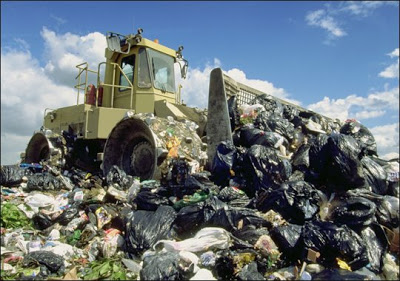Trash talk that makes sense
By Jessica Marshall / July 23, 2008
Within the next two years, some of us may be running our cars on trash.
Two companies — INEOS bio of Lyndhurst, U.K., and Coskata of Warrenville, Ill. — claim to be within reach of producing ethanol from garbage on a commercial scale.
INEOS bio announced this week that they plan to produce commercial quantities of waste-derived ethanol within two years. Coskata plans to have a commercial demonstration facility by mid-2009.
The companies use similar processes to turn municipal waste into ethanol. The first step is gasification, in which the waste is heated with limited oxygen to create carbon monoxide and hydrogen.
“It’s a very different process from incineration, where you completely combust in excess air,” which results in carbon dioxide and water, said INEOS bio’s Graham Rice. “We’re trying to go halfway and produce carbon monoxide, which still has a lot of chemical energy.”
The carbon monoxide and hydrogen mixture is then fed to bacteria, which convert the mixture into ethanol. The ethanol is then purified and blended with fuel.
“It’s a process which can take any form of carbon waste,” Rice said. Coskata’s Wes Bolsen agreed. “It might be trash. It might be tires. It might be biomass.”
Importantly, none of these starting materials is used for food, so this process sidesteps concerns over diverting food crops like corn into biofuel production.
The process also uses less than half the water needed to make ethanol from corn, Bolsen said. It uses as little as a quarter of the water that might be required to make ethanol from waste biomass or grass crops by digesting the plants’ cellulose and converting it to ethanol — seen as the next generation in biofuel production.
“The analysis we’ve done is that the greenhouse gas emissions we’d expect would be a 90 percent reduction compared to petrol [gasoline],” Rice added.
INEOS bio’s commercial facility in Fayetteville, Ark., will use green household waste, including compostable household clippings, food waste, mixed waste paper and cardboard. The company estimates that biodegradable household waste in the United States alone could make five billion gallons a year of ethanol, which is more than half of the current U.S. ethanol demand of nine billion gallons.
Coskata plans to run five different materials through their commercial demonstration plant: wood chips, sugar cane waste, municipal waste, natural gas and a potential energy crop such as switchgrass.
“We’re looking at one dollar a gallon production cost,” Bolsen said, “which competes directly with [the cost of ethanol from] Brazilian sugarcane, and we can do it here in the U.S.”
“Wherever there are people, wastes are generated,” Rice said. “What I’d like to see is every community converting its waste into renewable transport fuel.”
Source / Discovery News



















This is exciting – my grandfather’s farm was sold and turned into a huge county land-fill.
Wonderful news!
P.S. – We can call it ‘trash-gas’ (rhymes). Rhyme and reason – nice ‘R&R’. /ds